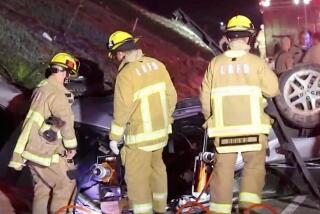You Canât Get There From Here
The traffic death of a human being was reported the other night on television in a segment that equated the magnitude of his death with what it did to the San Gabriel River Freeway.
âHe succeeded in killing himself and tying up the 605 for hours,â the newscaster said against the backdrop of a car burning furiously.
Then with only another slight reference to this humanâs demise, the reporter went on to discuss the traffic tie-up on the northbound lanes. The segment ended with him interviewing a woman who thought the delay was a darned pain.
I realized as I watched the piece how much more important the efficient flow of traffic is becoming in L.A.; more important than the lives of those who occupy the vehicles along our 750 miles of freeway.
Weâre a town desperate to get where weâre going, but finding it increasingly difficult to do so. âYou canât get there from here,â once the folksy mantra of the Northeast, applies to us in a considerably less whimsical fashion.
Freeways, the dream of the future, have become the nightmare of the present. And those who die on those ribbons of asphalt have become the annoying equivalent of a mattress in the fast lane.
Just another delay.
*
The man who perished in the flaming crash on the San Gabriel River Freeway was later determined to be wanted by police for allegedly slashing three people in a drug deal gone sour. We shrug. He did it to himself. That justifies insensitivity.
But we didnât know who he was when he crashed in flames against a brick wall, only that the manner of his death held up traffic on the freeway for at least three hours.
The irony of the juxtaposition of death and delay was not lost on me. No human agony is dismissible as a catalyst for a column, but it did focus my thinking about traffic in L.A.
Getting somewhere increases in importance to the deaths that block our progress because itâs getting harder to get anywhere. And itâs going to get worse. By one estimate, the population in L.A. County will increase by 3.5 million in 25 years. The peak morning commute speed is expected to drop from 34 mph to 20 mph or less.
Faced with this, the MTA is creating a transportation plan that will include more subway and light-rail projects, notably links to Westwood and LAX. But this plan, like so many others, has about as much chance of becoming a reality as Britney Spears has of becoming an Oxford don.
Cities will fight it, neighborhoods will fight it, lawmakers will fight it and dogs will chase engineers from their streets. The kind of opposition that doomed the last plan to failure will be after this one too. Count on it.
L.A. needs efficient mass public transportation beyond freeways. Without it, there will come a day when, like a science fiction scene, the world we know will come to a halt.
*
Bill Stokes confronted all the arguments against rail and subways when BART was being created in the San Francisco Bay Area. He plunged through them like a running back going for a goal and helped create a system second to very few.
Stokes was a reporter for the Oakland Tribune when he left to join BART in 1958 as its communications director. He became its general manager five years later.
By gaining public support despite opposition that included a taxpayer suit, Stokes and his crew masterminded passage of a $792-million bond issue that ultimately created todayâs 100-mile system.
âWe saw that freeways were a thing of the past,â he said by telephone from his Virginia home. âThere was no place to put any more of them in San Francisco, and I suspect that youâre reaching that point too.â
He dismisses the awkward, decades-long efforts of L.A. to create an adequate transit system as a reliance on âblack magic.â He adds that the MTA should build public support rather than patch together a piecemeal system. The longer we wait, Stokes warns, the higher the cost will go . . . and the more desperate weâll be to get where theyâre going.
Our major effort in the area of mass transit has been to add buses. What we donât need in L.A. are more vehicles joining the 6.1 million already clogging our streets and freeways. We donât need the desperation that accompanies congestion.
I keep thinking of the man on the freeway. I keep thinking of the growing importance of freeway transit over human life. And I keep wondering where weâre going and how weâre going to get there as the years pass and the traffic slows.
*
Al Martinezâs column appears Sundays and Wednesdays. He can be reached online at [email protected].
More to Read
Sign up for Essential California
The most important California stories and recommendations in your inbox every morning.
You may occasionally receive promotional content from the Los Angeles Times.










